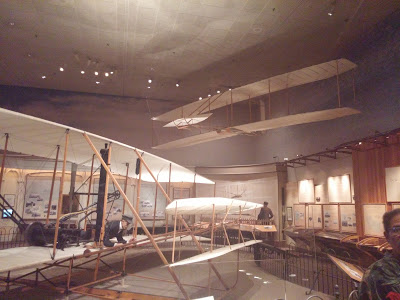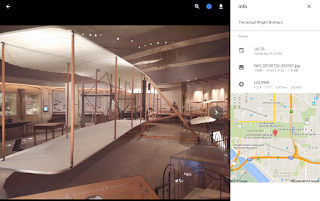A Day Learning about Early Aviation

Yesterday, I went on a day long tour of early aviation artifacts and sites located in the Washington DC area organized by Smithsonian Associates (link to tour)
The tour was lead by Paul Glenshaw. Paul was acknowledged for his help by David McCullough in his book :"The Wright Brothers", a book I read in preparation of this tour.
We first visited the National Air and Space Museum to view the early Wright gliders, and of course,the 1903 Wright Flyer.
We also saw Lilienthal's early glider, and the Langley Aerodrome. #5. This aircraft was flown successfully unmanned near my home, off of Chopawamsic Island (map) itself just off Quantico Marine Base.
The next visit was the Smithsonian Castle. The garden there was the site of Professor Langley's construction of the Aerodrome.
'
Afterwards we visited Haines Point, site of the unsuccessful attempt to fly the powered Aerodrome by pilot Charles Manly.
Next was the Air Force Memorial. And then Fort Meyer, where in 1908 Orville Wright demonstrated the Wright airplane for the U.S. Army. On one test flight, the plane crashed, injuring Orville, and killing Lt. Thomas Selfridge, making Selfridge the first airplane fatality.
In 1909 Orville successfully demonstrated the airplane's usefulness to the US Army at Fort Meyer. As part of the contract to sell a plane to the Army, the Wrights had to train two pilots. That training was done at College Park. After the Wright's left, training continued at the nascent College Park Airport, the oldest airport in the world.
The College Park Aviation Museum was our final visit.
I chose some photographs from the many I took, and captioned and shared them.
Note: click the first photo, and then Info button
to see captions and a map where the photo was taken. Hover your mouse over the right edge of the photo for an arrow to the next photo.
Note: click the first photo, and then Info button
to see captions and a map where the photo was taken. Hover your mouse over the right edge of the photo for an arrow to the next photo.
Google Assistant did the same programmatically.
This post was my way of documenting and remembering the day, but thought others might enjoy it too, if for no other reason then to know about the wonderful resource that is Smithsonian Associates.
Note: This blog post contains one Amazon Affiliate Link.



Comments
Post a Comment